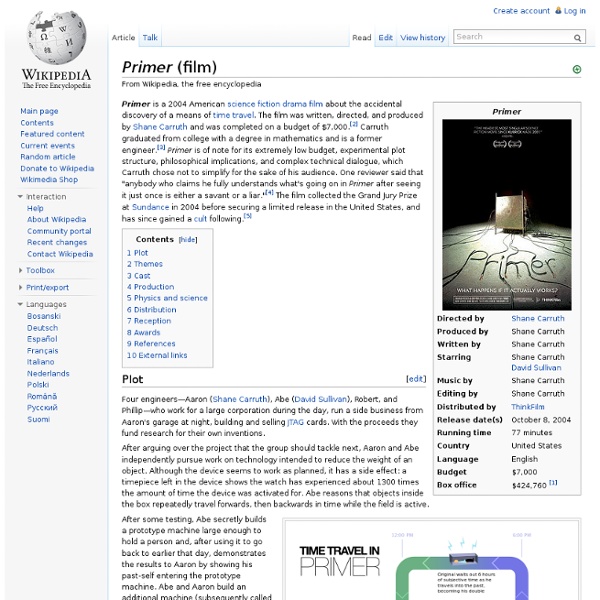Swingers (1996 film)
Mike Peters (Jon Favreau) is a struggling actor who left New York, and a girlfriend behind, to find success in L.A. The move caused his girlfriend of six years to split up with him six months earlier and left him feeling alone and heartbroken. In the opening scenes of the film, Mike talks about his situation with his friend Rob (Ron Livingston), another thespian from back east. On the ride home, Trent gets Mike to feel better about himself and to look at the positive side of things. Now back in L.A., Mike and Rob get together for some golf and to talk shop. The guys agree to head to their favorite after hours spot and after watching Trent and Sue effortlessly meet some girls, Mike is clearly shown feeling lower than ever but not yet defeated. The swingers leave the lounge and narrowly miss getting into a brawl in the parking lot caused by Sue's temper yet averted by Sue pulling a gun which no one else was aware was even a part of his attire. A still from Swingers Filming locations
Top 7 Movies of Dharmendra - Some heard, some unheard!! - FILMISTANI - Filmon Ki Kahani, Hamari Zubani !!
So after a long vacation, we are back. 2012 was an amazing year for Bollywood and 2013 seems to be doing even better with Chennai Express making 150 crores in 2 weeks and Jawani Deewani etc clocking almost 200 khokha. So we at Filmistani are going to take a deep breath, kill ourselves and become a ghost of 'Christmas Past'. From Dil Bhi Tera, Hum Bhi Tere to YPD, Dharmendra acted in nearly two hundred and fifty films and never won a Filmfare Best Actor award despite being discovered in a Filmfare talent spotting competition. Dharmendra is perhaps one of the most talked about superstars in the industry and rightly so. Directed by Satyen Bose starring Dharam ji and Rakhi, this movie depicts the internal tension and deconstruction that the lead character Ashok Tandon (Dharam Ji) goes through. Considered by many as the best war movie ever made in India, Haqeeqat by Chetan Anand was a realistic, cold and brutal peep into the immediate aftermath of the Indo-China war. 3) Anupama (1966)
chickenknuckles comments on How do you respond to clients that do not want to pay you the rate you have established for yourself?
Bollywood Recaps
Females of Reddit, does nipple sucking turn you on or is it just a stupid thing guys like to do? : AskReddit
Thodasa Roomani Ho Jaayen
Thodasa Roomani Ho Jayen is a Hindi movie directed by Amol Palekar and released in 1990. It features Anita Kanwar, Nana Patekar and Vikram Gokhale as major actors. This movie has become a part of management courses and study pertaining to human behaviour. The movie has a lot of poetry within itself. Songs and Dialogues[edit] (Bim: Do raato ke bich ek chhota sa din bechara hai...kya kare? Bim: Do ghaato ke bhic ek patli si dhaara hai....kya kare? (Song) Samandar ko baandhe aisa koi ghaat nahi, Kadmo ko thame aisi koi baat nahi. (Barishkar: Karlo jo chaho, ban lo jo chaho! Bim: Mein kar sakta hoon, Mein karta hoon, Muze karna hi hai, Mein karunga. (2) Yea! (Song) Samandar ko baandhe aisa koi ghaat nahi, Kadmo ko thame aisi koi baat nahi. Ghaat "Ghaat" hi rehte hai...wo "Samandar" ho jaati hai! Details[edit] The movie was shot in Panchmarhi in Madhya Pradesh External links[edit] Thodasa Roomani Ho Jaayen at the Internet Movie Database
You will never be whole until you make peace with what turns you on. : sex
How Spielberg Made Millions Off of Star Wars
A tale of two directors -- and two and a half points. By Max Nicholson It's a pretty well-known bit of Star Wars trivia that George Lucas had serious problems with assembling the first cut of A New Hope. Throughout production and post-production the filmmaker was faced with an onslaught of obstacles, both in-house and with the studio. Apparently, Lucas was so depressed at one point that he took a vacation to visit his friend Steven Spielberg, who was working on Close Encounters of the Third Kind at the time. According to Celebrity Networth, Spielberg revealed that, while on set, Lucas made a bet with him regarding Star Wars -- a bet that has continued to pay off handsomely for Spielberg ever since. "George came back from Star Wars a nervous wreck," Spielberg said. "He said, 'Oh my God, your movie is going to be so much more successful than Star Wars. How much money, you ask? Got feedback on our player? We want to hear it. Via Slash Film
Men of Reddit: what is some of the "guy code" things that girls probably do not know about? : AskReddit



